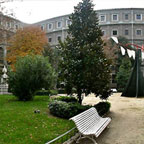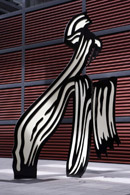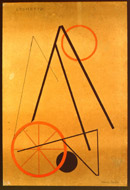While I was pursuing a degree at Université de Rennes II (France) in French Studies with a specialty in Art History, I got “schooled,” French-style, by my civilization professor one day in class. “Where is Picasso’s greatest work housed?” he queried, looking me straight in the eye. I was shocked for two reasons. First, the French educational style is primarily based on lecture (by professors) and silent note taking (by students); there is very little actual interaction between students and professors either during or outside of class. Second, I couldn’t believe that he was really directing the question at me, one of two American students in his class of over 100 people. “At the Musée Picasso in Paris?” I ventured. “Mais non!” He replied. “The Guernica is at the Museo Nacional Centro de Arte Reina Sofia in Madrid…oh là, les américains!”
 As I slunk back down in my seat, heart racing, I vowed to 1) laugh off this situation with friends over a Breton cider as soon as my humiliation passed and 2) visit the Museo Nacional Centro de Arte Reina Sofia, stat! I am happy to say that I accomplished both goals. Since my original shame-induced pilgrimage, I’ve been to the Reina Sofia on several occasions. Each time I become even more impressed by their vast collection and curatorial panache.
As I slunk back down in my seat, heart racing, I vowed to 1) laugh off this situation with friends over a Breton cider as soon as my humiliation passed and 2) visit the Museo Nacional Centro de Arte Reina Sofia, stat! I am happy to say that I accomplished both goals. Since my original shame-induced pilgrimage, I’ve been to the Reina Sofia on several occasions. Each time I become even more impressed by their vast collection and curatorial panache.
 In addition to a wide variety of visiting exhibitions, the Reina Sofia displays an interesting mix of pieces from its permanent collection. The collection is organized chronologically and divided into four categories: Historical Avant-Garde Movements, The Triumph and Failure of Modernity, Change in Paradigm, and Contemporary Art. In addition to the museum’s impressive collection of Picasso paintings and sketches, visitors will enjoy works by contemporary art masters such as Yves Klein (French), Max Ernst (German), Marcel Duchamp (French), Francis Picabia (French), Dan Flavin (American), Roy Lichtenstein (American), Óscar Domínguez (Spanish), and Julio González (Spanish)- among others.
In addition to a wide variety of visiting exhibitions, the Reina Sofia displays an interesting mix of pieces from its permanent collection. The collection is organized chronologically and divided into four categories: Historical Avant-Garde Movements, The Triumph and Failure of Modernity, Change in Paradigm, and Contemporary Art. In addition to the museum’s impressive collection of Picasso paintings and sketches, visitors will enjoy works by contemporary art masters such as Yves Klein (French), Max Ernst (German), Marcel Duchamp (French), Francis Picabia (French), Dan Flavin (American), Roy Lichtenstein (American), Óscar Domínguez (Spanish), and Julio González (Spanish)- among others.
 Since opening its doors in 1990, the ultra-contemporary Reina Sofia has served as much more than a museum. The Centro maintains a commitment to supporting contemporary artists in myriad genres, including the performing arts. In addition, Reina Sofia is recognized for its educational programs that help to make art accessible to a wide audience, spanning both age groups and social classes. To accommodate the rapid growth of its world-renowned collection and programming, Reina Sofia was expanded under the leadership of French architect, Jean Nouvel (who also designed Paris’ sensational Quai Branly Museum). The construction on the new addition began in 2001 and was completed in 2005. Nouvel’s design increased the museum’s size by over 60% and opened up a public square that serves as a lecture and performance space.
Since opening its doors in 1990, the ultra-contemporary Reina Sofia has served as much more than a museum. The Centro maintains a commitment to supporting contemporary artists in myriad genres, including the performing arts. In addition, Reina Sofia is recognized for its educational programs that help to make art accessible to a wide audience, spanning both age groups and social classes. To accommodate the rapid growth of its world-renowned collection and programming, Reina Sofia was expanded under the leadership of French architect, Jean Nouvel (who also designed Paris’ sensational Quai Branly Museum). The construction on the new addition began in 2001 and was completed in 2005. Nouvel’s design increased the museum’s size by over 60% and opened up a public square that serves as a lecture and performance space.
Museo Nacional Centro de Arte Reina Sofia is open Monday to Saturday from 10am to 9pm and Sundays from 10am-2:30pm. Like many museums in Europe, it is closed on Tuesdays and major holidays. The admission price is reasonable at 6 euros for general admission and 3 euros for students and seniors.


Comments